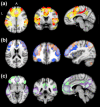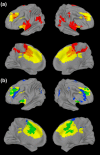The goal priority network as a neural substrate of Conscientiousness
- PMID: 29691946
- PMCID: PMC6200659
- DOI: 10.1002/hbm.24195
The goal priority network as a neural substrate of Conscientiousness
Abstract
Conscientiousness is a personality trait associated with many important life outcomes, but little is known about the mechanisms that underlie it. We investigated its neural correlates using functional connectivity analysis in fMRI, which identifies brain regions that act in synchrony. We tested the hypothesis that a broad network resembling a combination of the salience and ventral attention networks, which we provisionally label the goal priority network (GPN), is a neural correlate of Conscientiousness. Self- and peer-ratings of Conscientiousness were collected in a community sample of adults who underwent a resting-state fMRI scan (N = 218). An independent components analysis yielded five components that overlapped substantially with the GPN. We examined synchrony within and between these GPN subcomponents. Synchrony within one of the components-mainly comprising regions of anterior insula, dorsal anterior cingulate cortex, and dorsolateral prefrontal cortex-was significantly associated with Conscientiousness. Connectivity between this component and the four other GPN components was also significantly associated with Conscientiousness. Our results support the hypothesis that variation in a network that enables prioritization of multiple goals may be central to Conscientiousness.
Keywords: Conscientiousness; functional connectivity; goal priority network; resting state fMRI; rs-fcMRI; salience network; ventral attention network.
© 2018 Wiley Periodicals, Inc.
Figures





References
-
- Ackerman, P. L. , & Heggestad, E. D. (1997). Intelligence, personality, and interests: Evidence for overlapping traits. Psychological Bulletin, 121(2), 219–245. - PubMed
-
- Allen, T. , & DeYoung, C. (2016). Personality neuroscience and the five‐factor model. Oxford Handbooks Online.
Publication types
MeSH terms
Grants and funding
LinkOut - more resources
Full Text Sources
Other Literature Sources
Medical

